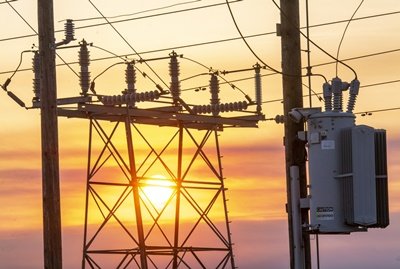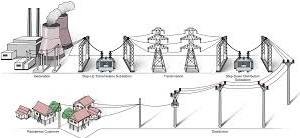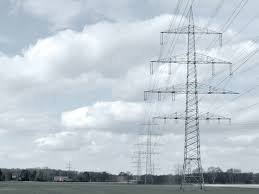
In the high voltage transmission, Power stations usually generate an alternating current a.c at a voltage between 11KV and 25KV. The power generated is then stepped up to 132KV-400KV so that it can be transmitted to long distances from the power station. The electrical power is usually transmitted over long distance to substations where the voltage is stepped down to 11KV. From the substations, power is distributed to consumers after it is being stepped down to the consumable levels according to the needs of each consumer. Consumers can be heavy industry that may need over 30KV, light industry that may need over 10KV or domestic homes that may need only 240V.

Dangers of High Voltage Transmission
- risk of electric shock incase poles collapse or cables hangs too low
- The cables can cause fire on nearby structure and vegetation when cables are too loose
- Because of the high voltage, there is strong electric fields that can interfere with health of people exposed to such fields.
- During thunder and lightening, the cables can conduct excess charges from the lighting causing danger to houses and machines using electricity.
- during strong wind, the cables can come into contact with each other causing fire.
Power losses During High Voltage Transmission
Given that; I=current flowing, V=voltage supplied and R =electrical resistance in the High voltage transmission cables :
Power dissipated in a circuit is given by ; P=VI
From ohm’s law V = IR. Hence, P = (IR)I = I2R
This means that for a given resistance in a circuit, when the current is high , the power loss is large and when the current is low, the power loss is small.
Power loss in High voltage transmission is therefore low when it is transmitted at high voltage and low current.
To attain high voltage and low current, output voltage from power station is stepped up for long distance transmission so as to minimize power loss in transmission cables. This is done by ensuring the current is as low as possible with the same power output.
Since long distances are involved, transmission cables are thick and made from very good conductors of electric current to ensure resistance is kept to minimum.
aluminum cables are preferred in high voltage transmission because :
- It is a good conductor of electric current
- It can be obtained cheaply
- It is light
Example problem
The resistance a of power transmitting cable is 10Ω and is used to transmit 11Kv at 1A current. If this voltage is stepped-up to 16kv by a transformer, determine the power loss.
solution
assuming the transmission is 100% efficient:
power input = power output
VpIp = VsIs
11000 x 1 = 160 000 x Is

= 0.069A
power lost = I2R = (0.069)2 x 10 = 0.048W
If there was no stepping up of the voltage the power loss would be:
power loss = (1.0)2 x 10 = 10W which is actually 200 times wastage compared to power calculated above.
Practice Question
A generator produces 750kW at a voltage of 15kV. This voltage is then stepped up to 125kV so that it can transmitted through cables of resistance 0f 500Ω to a step-down transformer in a substation. Assuming that both transformers are 100% efficient:
(a) calculate:
(I)The current produced by the generator
(ii) the current that flows through the transmission cables
(iii) the voltage drop across the transmission cables
(iii) power lost during transmission
(iv) power that reaches substation
solution
(I)
power input = Voltage in primary coil x Current in the primary coil
that is: power input = Vp x Ip
Current in primary Ip will therefore be given us:
and substituting for the values of power and primary voltage we have:
so the current produced originally in the primary coil is 50.0A
(ii)
At the step-up transformer;
power input = power output (no power is lost because the transformer is 100% efficient)
that is: power in primary generator = power after step up
Vp x Ip = Vs x Is
15000V x 50A = 125000xIs


Leave a Reply